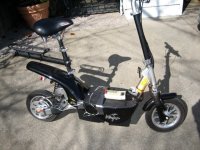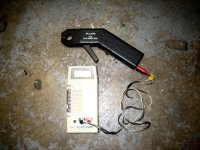I borrowed the clamp on AC/DC amp probe from work and did a quick test. Not super scientific, since I had a hard time loading the motor enought to get full amps.
I have my trusty analog meter on the battery wire, and the clamp on over one of the three phase wires. For maximum current draw, I was starting from a dead stop on an 18% grade. With the brakes on in some cases.
The maximum "multiplication effect" seemed to be around 25 amps input, where I was measuring around 100 amps output.
As the motor picked up speed and the duty cycle increased, the output/input ratio dropped.
For a 35 amp limited controller, the motor will see a little over 100 amps at low throttle settings.
The highest reading I could get was around 170 amps with my 90 amp input limit. I was not using a meter with a min / max memory, so the readings had to stay there a second or so to read them.
I have my trusty analog meter on the battery wire, and the clamp on over one of the three phase wires. For maximum current draw, I was starting from a dead stop on an 18% grade. With the brakes on in some cases.
The maximum "multiplication effect" seemed to be around 25 amps input, where I was measuring around 100 amps output.
As the motor picked up speed and the duty cycle increased, the output/input ratio dropped.
For a 35 amp limited controller, the motor will see a little over 100 amps at low throttle settings.
The highest reading I could get was around 170 amps with my 90 amp input limit. I was not using a meter with a min / max memory, so the readings had to stay there a second or so to read them.




